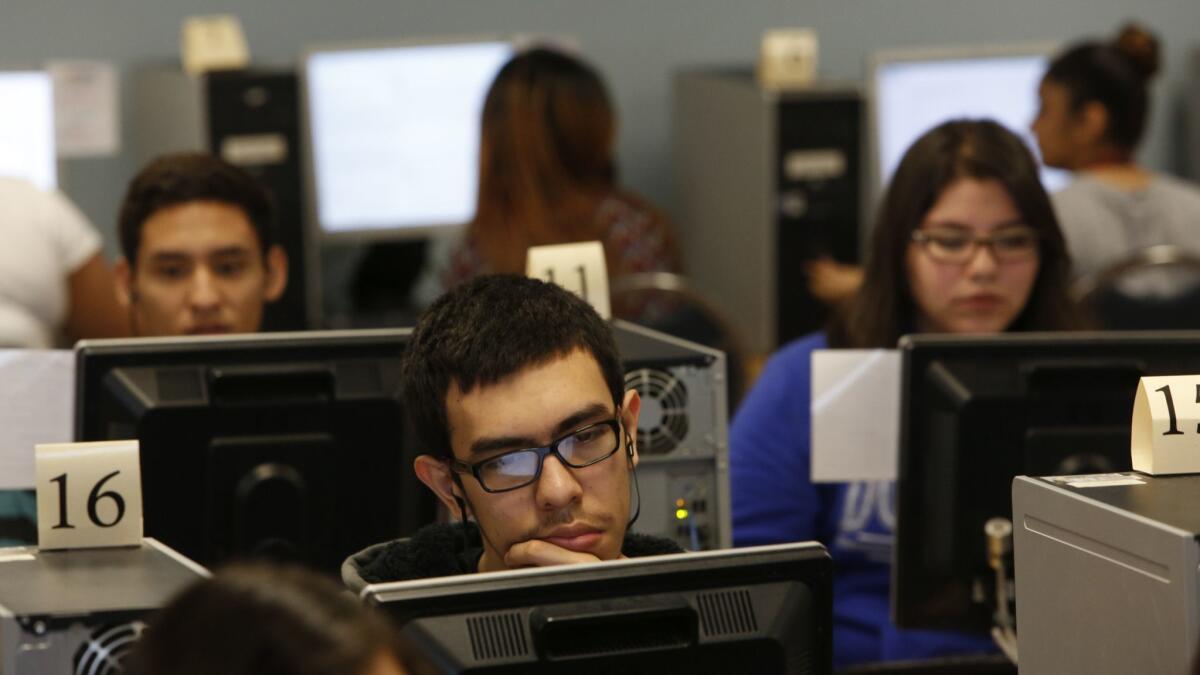California’s standardized test scores inch up overall — but hit a high school snag

- Share via
California students’ standardized test scores inched up this year, though gains among younger students were nearly canceled out by a drop at the high school level.
More than 3 million students in third through eighth grade and 11th grade took the California Assessment of Student Performance and Progress in the spring. The pace of improvement was a little better than last year, but the results were hardly cause for celebration. Just under half the students met standards in English and fewer than 4 in 10 in math.
Still, officials accentuated the positive.
The strongest gains were in reading scores in third grade (up 4.3 percentage points) and fourth grade (up 3.6 percentage points). The youngest students tested also made the biggest strides in math, although those gains were not as large.
Los Angeles Unified, California’s largest school system, improved at a faster rate than the state overall, though its scores still fell below state averages. About 42% of L.A. Unified students met or exceeded state standards in reading, while about 32% did so in math.
“L.A. Unified’s modest growth shows we have more work to do, especially with our African American, Latino and low-income students,” Supt. Austin Beutner said. “The status quo is simply not good enough. While magnet schools continue to show higher rates of English and math proficiency, we need to make sure all Los Angeles Unified students get the great education they deserve.”
The tests don’t cover every subject and test scores are far from the only proper measure of an effective school, but they remain a widely used snapshot of progress.
The tests still are relatively new. They were introduced four years ago. They are taken on computer, not with pencil and paper, and they aren’t purely multiple choice. The new system was intended to match more closely, grade by grade, what students need to learn to eventually be ready for college or career training. The changes drove scores downward, suggesting that students were less prepared than the older tests had indicated.
Many questions on the test still are multiple choice, but a correct answer produces a harder question to follow, while a wrong answer yields an easier next question. This “adaptive” test seeks to precisely diagnose what a student needs to learn. The test also includes what the state calls a performance task, which requires analysis and writing.
It isn’t just the test that has changed. California also revamped its learning goals, with an increased emphasis, for example, on analytical writing and reading and on studying more difficult nonfiction.
Officials said they see a payoff from the new priorities and teaching methods.
“That our younger learners who have experienced standard-aligned instruction since kindergarten are improving faster is encouraging,” said State Board of Education President Michael W. Kirst.
Ideally older students also should be demonstrating improvement. But 11th-graders in this testing round scored nearly 4 percentage points below those in the year before. In fact, the performance of 11th-graders has gone down slightly since the new testing program started.
Students in 11th grade also performed worse in math than their peers the year before, although the dip was much smaller.
Another source of disappointment was the state’s limited progress in closing the gap that separates Asian and white students from black and Latino students. One example: 32% of black students met the standard in reading compared to 76% of Asians and 65% of whites. The gap in reading narrowed slightly for blacks and Latinos in 2018, by less than 1 percentage point, as did the gap in math for Latinos. But the math gap widened slightly for black students.
“We still see large and persisting gaps, which in a state like California that educates one out of every 10 K-12 students,” said Elisha Smith Arrillaga, a senior official with Education Trust-West, an advocacy group. “That’s just too slow.”
At the current rate of improvement, it would take generations for black students to catch up.
“I have a son and … I would never be content to know that it would be his grandchildren, and not him, that have the educational opportunities that he deserves. And that’s the pace that we’re currently going,” Arrillaga said.
A lot of it comes down to the schools the students attend, said UCLA education professor Patricia Gandara.
“California has the most segregated schools in the country right now for our black and brown kids,” she said.
Gandara did not take issue with the difficulty of the test.
“It looks like the standards that are being set are reasonable if three-quarters of the Asian kids … and two-thirds of the white kids are meeting or exceeding them. We want the same for all children,” she said.
Statewide, you have to look on the right side of the decimal point to get a clear picture of the progress. In English, 49.9% of students met or exceeded state standards in English, compared to 48.6% last year. In math, 38.7% met the standard compared to 37.6% last year.
The biggest gains so far were in the test’s second year, when students benefited over the previous year from an increasing familiarity with the format and better computer technology.
Schools have had 2018 results since May, but the public release was later than usual this year, especially given that officials had promised a quick turnaround for the computerized exams.
This year’s delay, according to the state, was because of a single eighth-grade math question that was incorrectly categorized, resulting in a “scoring anomaly.” About 30% of eighth-graders received the question, and the tests had to be rescored.
Twitter: @howardblume
More to Read
Sign up for Essential California
The most important California stories and recommendations in your inbox every morning.
You may occasionally receive promotional content from the Los Angeles Times.












